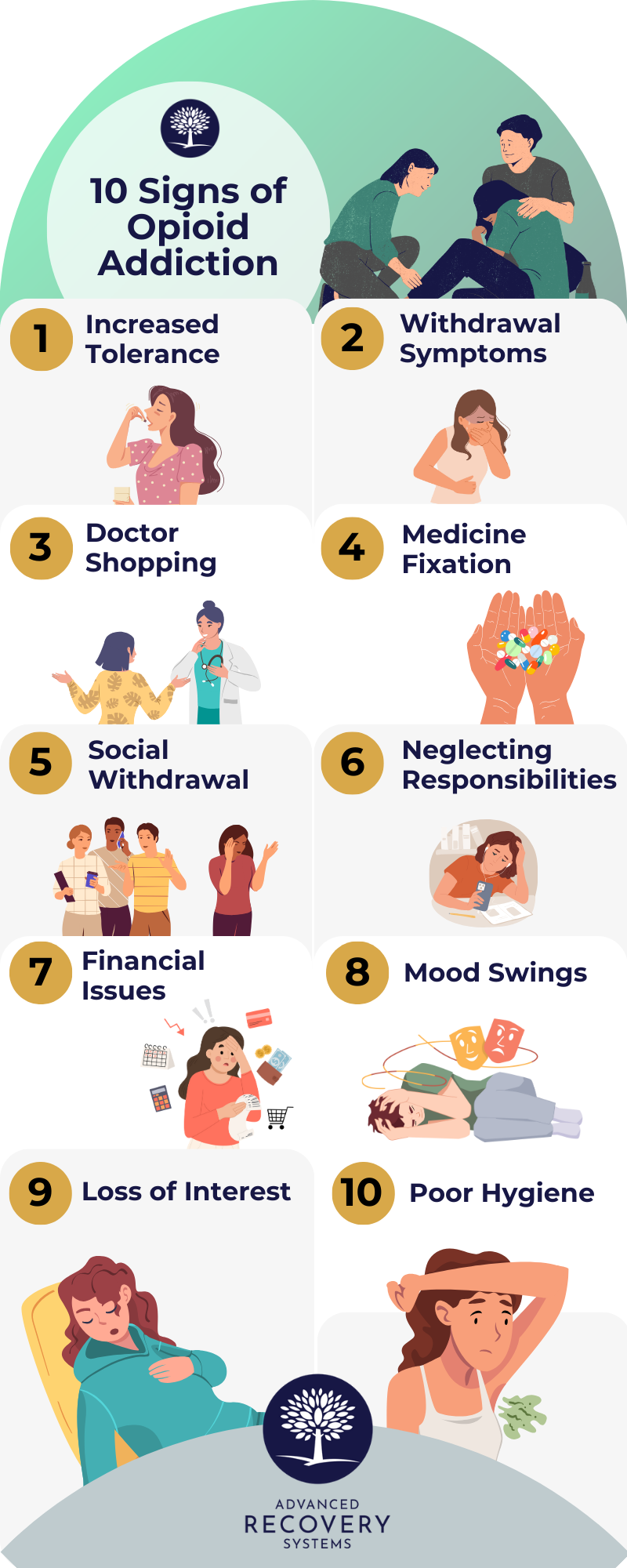Opioids are a class of drugs derived from opium, a plant. Some opioid drugs have medical uses such as morphine and hydromorphone, while others, such as heroin and carfentanil, have no medical use. When used, opioids activate opioid receptors in the brain which causes the brain to release endorphins. This reaction can cause a craving for more of the drug and lead to addiction.
Beyond its addictive qualities, opioids suppress the nervous system and slow bodily functions, like breathing or heart rate. So the more opioids a person takes, the more stress they’re putting on their body and the more likely they are to overdose.
Persistent opioid use can lead to dependence, where the body becomes accustomed to the presence of opioids and changes its functions to adjust for the presence of opioids. Dependence makes it difficult to quit opioids, as the body must readjust for the absence of opioids in the bloodstream.
Symptoms of Opioids Abuse
There are symptoms when someone misuses opioids. Signs of opioid abuse can be both physical and psychosocial. Physical signs of opioid abuse include constipation, excessive sleepiness, fatigue and decreased breathing.

It's time to get your life back.
If you are struggling with addiction and co-occurring mental health, our expert team is here to guide you every step of the way. Don’t wait— reach out today to take the first step toward taking control of your life.
Opioid abuse symptoms will also typically include withdrawal symptoms when drug use is stopped. Symptoms of withdrawal include:
- Sweating
- Excessive tear production
- Runny nose
- Enlarged pupils
- Stomach cramps
- Tremors
- Rapid heartbeat
- Fever
- Irritability
- Elevated blood pressure
- Chills
- Nausea
- Vomiting
- Diarrhea
- Weight loss
Someone experiencing withdrawal was likely using opioids illicitly or beyond what was medically intended.
Psychosocial signs of opioid abuse are more related to behavior. These signs of opioid abuse include:
- Using or obtaining an opioid illegally
- Lying about opioid use
- Irritability, anger, or guilt when speaking with others about opioid use
- Decreased performance at work or school
- Financial difficulty related to spending on opioids
If you see these symptoms in yourself or a loved one, it’s important to seek professional treatment to address the addiction and any co-occurring disorders present. Professional addiction treatment centers can help patients through withdrawal symptoms and set them up for continued success in recovery.
Side Effects of Opioids
While opioids may decrease pain and cause a high, several undesirable and dangerous side effects may be present even when they’re not abused. Side effects of opioid use include:
- Constipation
- Constricted pupils
- Nausea
- Decreased sex drive
- Fatigue
- Slurred speech
- Falling asleep during the day
- Problems waking up
- Decreased breathing
- Overdose
These side effects can also lead to the development of other health problems. Constipation, for instance, could lead to long-term bowel problems.
Side Effects of Long-Term Opioids Abuse
Long-term opioid use side effects include the development of tolerance and dependence. Tolerance is dangerous because as the body develops a need for larger doses to experience the same high, the physical response to the increased amount of opioids does not adjust as fast. This change leads to the body needing larger doses of opioids to achieve the original high.
Another side effect of long-term opioid misuse is the decreased ability to manage severe pain. Patients may initially consult with a family physician to attempt to address chronic pain. In the past, some physicians continually prescribed opioids to their patients to treat their pain. Unfortunately, individuals who are accustomed to large amounts of opioid medications will have a hard time managing pain following surgery or an injury. Long-term opioid misuse can lead to circumstances where the pain is completely uncontrollable.
Signs of Opioids Overdose
The deadliest aspect of opioid misuse is the potential for opioid overdose. According to the Centers for Disease Control and Prevention, 68 percent of the approximate 70,200 drug overdoses that occurred in 2017 involved opioids.

Opioid overdose symptoms include:
- Slowed breathing
- Difficulty awakening
- Unresponsiveness
- Shallow breaths
- Impaired judgment
- Not breathing
- Death
If you believe that you or a loved one are experiencing an opioid overdose, call 911 immediately. Overdose can lead to irreparable brain damage or death and should be treated by medical professionals as soon as possible.
If you or a loved one struggle with an addiction to opioids, the Recovery Village Ridgefield is ready to help. Our dedicated staff provides individualized treatment that addresses addiction alongside any co-occurring disorders that may be present. Contact us today to learn more about how we can provide the treatment you need.



